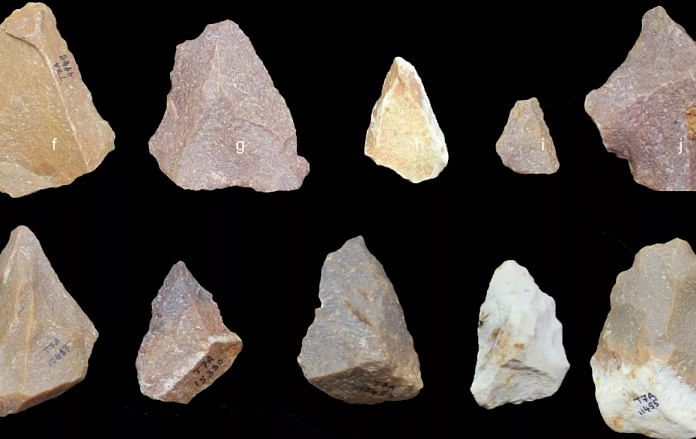We place these early Middle Palaeolithic cultures far earlier than estimated in India. Current models believe this phase came only about 125,000 years ago.
Our findings are the outcome of a multi-disciplinary teamwork carried out for over 20 years. Previous work at this site had focussed on the earliest Lower Palaeolithic Acheulian cultures. This work is on the overlying Middle Palaeolithic horizons.
Our message is simple: We state that around 380,000 years ago, and until around 172,000 years ago, there was a slow cultural transition occurring in India, that led to the establishment of a Middle Palaeolithic culture (MP), differing in many ways from the preceding Lower Palaeolithic culture (Acheulian), seen at this site. Many other younger MP sites are found elsewhere in India, and there are sure to be more as old as this.
We place these early MP cultures far earlier than what was estimated in India. One of the current models believes that this phase was brought to India by modern humans only post 125,000 years ago. While this is certainly occurring, we also see this culture at our site far earlier than presumed.
These cultural shifts are seen in the changes in the stone tool assemblages noted at the site. We have classified the entire MP culture at the site into two phases: an earlier one showing very archaic elements, e.g. vanishingly few handaxes, and a later phase. We do this not merely by picking and choosing tools (e.g. handaxes or Levallois technologies) but by a holistic look at the entire assemblage and its differences from the preceding Acheulian culture. Owing to the complete stratified sequence seen here, we have a wonderful chance to examine changes through time.
We are extremely cautious about linking stone tools with species, and thus are very careful in avoiding speculation as to who the tool makers were, as we lack sufficient hominin fossils in India. They could very well be archaic species or later on modern humans. We just don’t know as yet.
We also don’t know to what degree local innovations and external influences led to the development of the Indian MP. There are too few sites dated and sparse projects to resolve these big questions at this point in time.
We don’t pretend to have all the answers, just some more clues to fill in a giant puzzle in a systematic manner.
Obviously we expect this to generate huge debate and critique, as new data and interpretations that suggest alternate paradigms always do. We hope that others can answer the questions we raise through new discoveries and interpretations. That’s the way science progresses.
We call for corporate multinationals to step forward to support this branch of archaeological research. We hope that we can get adequate support and funding to carry out more research along these lines, to bring alive India’s often “forgotten heritage”.
Our team includes research in archaeology and excavations at the site of Attirampakkam, (Dr Kumar Akhilesh and Shanti Pappu from the Sharma Centre for Heritage Education), geochronology (A.K. Singhvi, H. Rajapara and A.D. Shukla from Physical Research Laboratory, India) and geomorphology (Yanni Gunnell, Univ. Lyon, France). We thank the Archaeological Survey of India and State Department of Archaeology, Tamil Nadu, for all their support.
Shanti Pappu is the secretary (honorary) at Sharma Centre for Heritage Education, and one of the authors of the research article in Nature.



